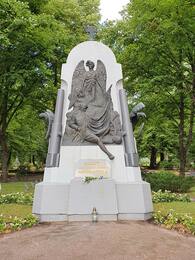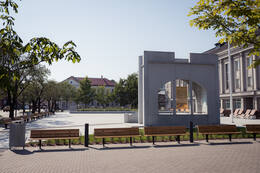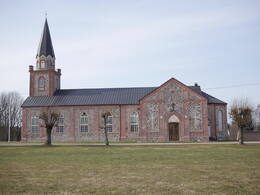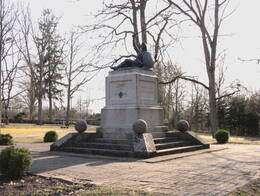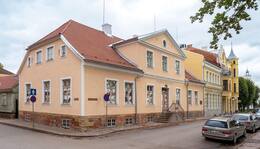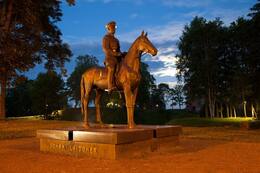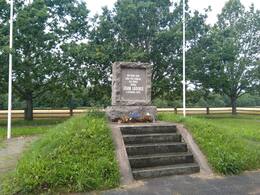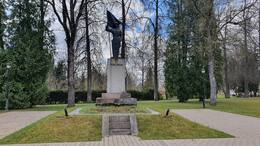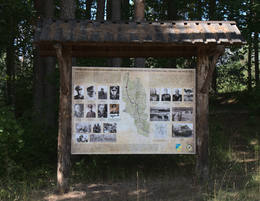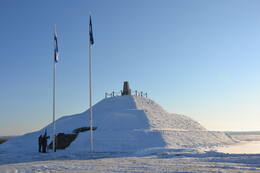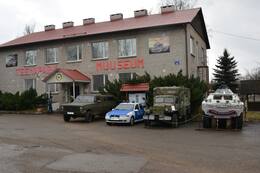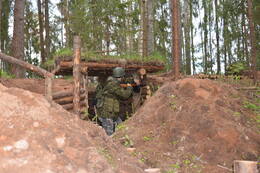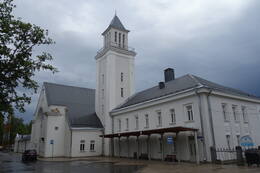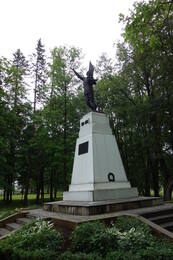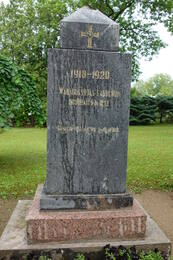Estijos nepriklausomybės karo pėdsakais
Pernu Laisvės kovų paminklas
Šį paminklą suprojektavo Amandus Adamson. Jis buvo atidengtas Alevi kapinėse Pernu mieste 1922 m. liepos 16 d. Jo autorius buvo palaidotas šalia 1929 m.
1945 m. balandžio 15 d. paminklas buvo susprogdintas į šipulius, kurie vėliau buvo palaidoti. Berniuko su girlianda statulą už 175 metrų nuo paminklo palaidojo vietos vidurinės mokyklos mergaitės. Laimei, kareivių kapai liko nepaliesti.
Įgulos kapinės buvo atnaujintos 1987 m., o paminklo dalys (įskaitant berniuko su girlianda statulą) buvo atkastos 1988 m. 1989 m. vasario 24 d. buvo atidengta viršutinė paminklo dalis, kuri buvo rasta palaidota originalioje vietoje, su granito lentele su užrašu: „1918 1920 / ČIA BUVO ATIDENGTAS, 1922 M. LIEPOS 16 D. PAMINKLAS / ŽUVUSIEMS NEPRIKLAUSOMYBĖS KARE / SKULPTURIUS AMANDUS ADAMSON / SUNAIKINTAS 1945 M. / 1989 M. II 24 D.“ Paminklo ir kapinių restauravimas buvo atliktas etapais. Paminklas iš naujo atidengtas 1993 m. liepos 17 d.
Estijos Respublikos Nepriklausomybės paskelbimo paminklas
Šis paminklas yra Nepriklausomybės aikštėje, Pernu centre.
Pagaminta iš granito, ją suprojektavo Kaarel Eelma, Mart Aas ir Mikk Mutso, ji buvo atidengta 2008 m. netoli buvusios Endlos teatro vietos.
1918 m. vasario 23 d. iš minėto teatro balkono, kuris buvo smarkiai apgadintas Antrojo pasaulinio karo metu ir vėliau nugriautas, pirmą kartą buvo viešai paskelbtas Estijos tautų manifestas.
Paminkle pavaizduotas originalaus dydžio istorinio teatro balkonas. Jame manifesto tekstas išspausdintas tiek originaliu juodu šriftu, tiek „Antiqua“ šriftu, taip pat Brailio raštu.
Manifestas buvo paskelbtas ir vasario 24 d. sostinėje Taline paskelbta Estijos Respublika, visus įgaliojimus perduodant Estijos gelbėjimo komitetui, o vėliau – Laikinajai vyriausybei. 1918 m. vasario 24 d. iki šiol minima kaip Estijos Respublikos metinės.
Estijos kareivių atminimo bažnyčia Tori mieste
Pernu apskrityje esanti Tori bažnyčia, pastatyta 1854 m., turi sudėtingą praeitį. Vokietijos armija bažnyčią sudegino 1944 m., traukdamasi nuo Raudonosios armijos. Kai 1990 m. buvo pradėta restauruoti bažnyčia, joje jau augo medžiai. Bažnyčia buvo pašventinta 2001 m. kaip memorialas visoms Antrojo pasaulinio karo aukoms ir dabar žinoma kaip Estijos kareivių memorialinė bažnyčia. Bažnyčia taip pat naudojama kaip koncertų vieta.
Nepriklausomybės karo paminklas Suure-Jaani miestelyje
Šis paminklas buvo atidengtas Suure-Jaani kapinėse 1926 m. birželio 24 d., jį suprojektavo Amandus Adamson. Jame pavaizduotas sužeistas, bet vis dar laikantis iškeltą kardą senovės estų vadas Lembitu. Paminklas buvo nugriautas 1941 m. ir vėl 1950 m. Jis buvo restauruotas ir vėl atidengtas 1990 m. birželio 23 d. Po pirmojo nugriovimo bronzinė Lembitu statula buvo patalpinta vietos vykdomojo komiteto sandėliuke ir vokiečių okupacijos metu grąžinta į pradinę vietą. Po antrojo paminklo nugriovimo 1950 m. apgadinta bronzinė skulptūra, kuriai dabar trūko vienos rankos, buvo perduota Viljandi muziejui. 1990 m. paminklo restauravimui buvo nulieta nauja bronzinė skulptūra.
Viljandžio muziejus
Šis muziejus įsikūręs senoje vaistinėje Viljandžio centre.
Pagrindinėje abiejų aukštų ekspozicijoje pristatoma Viljandi apygardos istorija per amžius. Muziejuje taip pat rengiamos unikalios laikinos parodos.
Dalis pagrindinės parodos skirta regiono karinei istorijai: Pirmajam pasauliniam karui, Nepriklausomybės karui, Estijos Respublikos nepriklausomybės paskelbimui ir Antrajam pasauliniam karui. Muziejuje eksponuojamos karinės kolekcijos, įskaitant pulkininko leitenanto Martino-Friedricho Bergmanno, pulkininko leitenanto Arturo Tenno ir pulkininko Johanneso-Augusto Vellerindo kolekciją, kurią sudaro jų asmeniniai daiktai, ginklai, dokumentai, medaliai ir apdovanojimai. Taip pat eksponuojama 1999 m. muziejaus renovacijos metu atrasta medalių kolekcija, priklausanti Gynybos lygos Sakalos regioniniam padaliniui. 1940–1944 m. vokiečių ir sovietų propagandinė medžiaga ir karinė įranga iliustruoja Antrojo pasaulinio karo metus ir Estijos Respublikos išardymą. Dalis parodos skirta masiniams trėmimams ir miško brolių pasipriešinimo judėjimui. Muziejuje taip pat rodomi filmai, kuriuose aprašomos parodos.
Generolo Johano Laidonero paminklas
Generolo Johano Laidonerio jojimo statula yra netoli Viljandžio pilies kalvų.
Šis skulptoriaus Terje Ojaverio suprojektuotas paminklas buvo atidengtas 2004 m.
Skirta vyriausiajam vadui generolui Johanui Laidoneriui, tai buvo pirmoji ir iki šiol vienintelė jojimo statula Estijoje. Žymus kariškis ir politikas, gimęs šioje apskrityje, buvo pirmasis Viljandžio garbės pilietis.
Generolo Johano Laidonero gimtinė
Rabos ūkio sodyba Vardžos kaime, kurioje gimė generolas Laidoneris, neišliko. Manoma, kad ji buvo sunaikinta prieš Antrąjį pasaulinį karą, nes 1937 m. jos vietoje buvo pastatytas paminklas. Paminklas buvo nugriautas 1940 m. ir restauruotas 1990 m. Pastaraisiais metais žmonės generolo gimtadienio proga, vasario 12 d., senojoje sodyboje reguliariai uždega žvakutes.
Nepriklausomybės karo paminklas Tarvastu mieste
Šis paminklas buvo atidengtas 1937 m. birželio 23 d. mažame Mustlos miestelyje. Jis buvo nugriautas 1941 m. birželio 18 d. sovietų okupacijos metu, o iš naujo atidengtas 1942 m. liepos 12 d. vokiečių okupacijos metu. 1948 m. jis vėl buvo nugriautas, o 1990 m. buvo atidengtas restauruotas variantas. Paminklas buvo restauruotas pagal originalą, su tik nedideliais pakeitimais. Centrinė paminklo detalė yra bronzinis kareivis, vienoje rankoje laikantis vėliavą, o kitoje – skydą, kuriame pavaizduoti trys leopardai. Jis stovi ant granito cokolio, kuris savo ruožtu remiasi į dviejų pakopų pagrindą. Verta paminėti kareivio dėvimą šalmą: jis buvo sukurtas pagal garsųjį vokišką Stahlhelm, atspindintį „spalvingą“ tiekimo situaciją Nepriklausomybės karo metu.
Greitas tilto mūšio laukas
Tai yra gynybos linijos „Pėsčiųjų takas“ dalis. Valgos gynybos linija (Pėsčiųjų takas) buvo nutiesta palei Maže Emajõe-Koiva upės liniją 1944 m. birželio pradžioje. Šiaurinė linijos dalis baigėsi prie Vertsjervo ežero ir driekėsi nuo Pikasilos beveik iki pat Ligaste dvaro, esančio kairiajame Maže Emajõgi upės krante. Gynybos liniją sudarė dvi gynybos juostos, kartais siekiančios 10–12 kilometrų gylį. Fronto linija buvo aptverta spygliuota viela ir minų laukais. Visi tiltai ant Maže Emajõgi ir Koivos upių buvo sunaikinti (nors Pikasilos ir Jõgeveste tiltai buvo sunaikinti tik rugpjūčio 26 d. vidurdienį), o visi tiltai už gynybos linijos buvo paruošti sunaikinimui.
Raudonoji armija planavo likviduoti Narvos fronte dislokuotas vokiečių ir estų pajėgas, atakuojant per Tartu iš jų užnugario. Įgyvendindama šį planą, Raudonosios armijos 3-iojo Baltijos fronto vadovybė pasiuntė keturis dalinius į Emajegio liniją. Jų užduotis buvo kirsti Emajegio upę ir, judant ratu per šiaurinį Vertsjervo ežero krantą, su Vokietijos 18-ąja armija, dislokuota Narvos fronte, užimti Šiaurės Estiją. Jie taip pat planavo palaužti vokiečių pasipriešinimą Pikasilos-Valgos linijoje ir atkirsti vokiečių atsitraukimo kelią Rygos link.
Pietų Estijoje gynybą sudarė šešios Vermachto XXVIII ir XXXVIII armijų korpusų divizijos ir mažesni daliniai, o užnugarį gynė 207-oji pastiprinimo divizija. Operacijos pradžioje Raudonoji armija turėjo kiekybinį pranašumą gyvosios jėgos ir kovinės įrangos atžvilgiu. Vokiečių pajėgas daugiausia sudarė įvairios kovinės grupės ir mažesni daliniai. Gynyboje dalyvavę „Omakaitse“ daliniai buvo prastai aprūpinti ir turėjo žemą kovinę moralę.
Rugpjūčio 27 d. Raudonajai armijai pavyko kirsti Mažąją Emajegio upę ties Pikasila ir ten išlaikyti nedidelį tiltą. Iki rugsėjo 13 d. vokiečių ir estų „Omakaitse“ divizijai pavyko sustabdyti artėjančius Raudonosios armijos dalinius gynybos linijoje „Walk“. Rugsėjo 14 d. 3-iojo Raudonosios armijos Baltijos fronto divizijos pradėjo puolimą ir rugsėjo 17 d. pralaužė gynybos liniją.
Paju mūšio atminimo ženklas
Paju mūšis įvyko 1919 m. sausio 31 d. Nepriklausomybės karo tarp Estijos liaudies pajėgų Tartu-Valgos armijos grupės ir Latvijos šaulių Raudonosios armijos metu dėl Paju dvaro kontrolės. Mūšio metu estai perėmė strategiškai svarbaus Valgos miesto ir jo geležinkelio atšakos kontrolę. Mūšyje mirtinai sužeistas Estijos puolimui vadovavęs Julius Kuperjanovas.
Šį paminklą suprojektavo architektas Georgas Saaras. Buvo surengta kampanija paminklui surinkti. 1938 m. birželio 12 d. kertinį akmenį padėjo generolas Johanas Laidoneris. Pamatas buvo baigtas statyti 1940 m., tačiau pats paminklas dėl sovietų okupacijos nebuvo atidengtas. 1994 m. sausio 30 d., minint 75-ąsias Paju mūšio metines, prezidentas Lennartas Meri pagaliau atidengė paminklą.
Valgos karo muziejus – tematinis parkas
Šis muziejus ir pramogų parkas pristato Valgos ir Estijos vidaus saugumo ir karinę istoriją. Ši vieta puikiai tinka vasaros stovykloms su lauko veikla ir išvyka į Antrojo pasaulinio karo mūšio vietą prie Mažės Emajegio upės organizuoti. Programoje numatyta išmokti virti žirnių sriubą (populiarų patiekalą kariuomenėje), naudoti maskuojančius veido dažus ir orientuotis miške.
Teminio parko parodoje eksponuojama karinė technika, artilerija, Mi-8 sraigtasparnis, gaisrinė mašina, įvairių tipų kulkosvaidžių ir jūrų minų slėptuvė. Ekskursija baigiasi „Miško brolių“ bunkeryje, kur, iš anksto užsisakius, patiekiamas „Miško brolių“ geriamas alkoholinis gėrimas ir rūkytų kiaulienos taukų sumuštiniai su svogūnais. Rimtesniems entuziastams muziejuje eksponuojama didžiausia ginklų kolekcija Estijoje. Estijos gynybos pajėgos, Policijos ir sienos apsaugos valdyba, Gynybos lyga ir Vidaus saugumo tarnyba muziejuje rengia savo atliekamų pareigų demonstracijas. Prie jų prisijungia Latvijos policija, sienos apsaugos ir priešgaisrinės gelbėjimo tarnybos.
Gynybinė linija „Walk“
Valgos gynybos linija (Pėsčiųjų takas) buvo nutiesta palei Väike Emajõe-Koiva upės liniją 1944 m. birželio pradžioje. Šiaurinė linijos dalis baigėsi prie Vertsjervo ežero ir driekėsi nuo Pikasilos beveik iki pat Ligaste dvaro, esančio kairiajame Väike Emajõgi upės krante. Gynybos liniją sudarė dvi gynybos juostos, kartais siekiančios 10–12 kilometrų gylį. Fronto linija buvo aptverta spygliuota viela ir minų laukais. Visi tiltai ant Väike Emajõgi ir Koivos upių buvo sunaikinti (nors Pikasilos ir Jõgeveste tiltai buvo sunaikinti tik rugpjūčio 26 d. vidurdienį), o visi tiltai už gynybos linijos buvo paruošti sunaikinimui. Antroji linija ėjo palei Õhne ir Pedeli upes, o gynybiniai statiniai apėmė Tervos ir Valgos miestus, kurie buvo pertvarkyti į pasipriešinimo punktus.
Pagrindinę gynybos liniją sudarė du apkasų rinkiniai, svarbiausiuose ruožuose net trys ar keturi gerai išvystytų apkasų rinkiniai su jungiamosiomis sistemomis. Gynybos linijai tiesti vokiečiai pasitelkė rusų karo belaisvius ir jėga verbavo vietos gyventojus organizacijos „Todt“ sudėtyje.
Šioje vietoje atkurti apkasai ir gaisrinės. Šioje teritorijoje įsikūręs Valgos karinis pramogų parkas, kuris vadovavo pastangoms atkurti kalvos karo laikų išvaizdą. Lauko erdvė atidaryta 2015 m.; Valgos karinis pramogų parkas reguliariai organizuoja lazerinių ginklų mūšius ir kitus renginius.
Apkasai ir stulpai buvo atkurti buvusiose vokiečių įtvirtintose pozicijose. Teritoriją valdo Valgos karinis pramogų parkas, kuris vadovavo restauravimo darbams, siekiant atgaivinti kalvagūbrio karo laikų išvaizdą. Lauko zona, kurioje dabar vyksta lazerinio šaudymo ir specialūs renginiai, buvo atidaryta 2015 m.
Vokiečių karo belaisvių pastatyta Valgos geležinkelio stotis
Pagrindinis Valgos geležinkelio stoties pastatas (Leningrado transporto planavimo biuras, architektas: Viktoras Cipulinas) buvo baigtas statyti 1949 m. Tai pailgas dviejų aukštų statinys su priestatu ir šlaitiniu stogu, kurio architektūrinis akcentas – septynių aukštų kvadratinis bokštas. Tai vienas geriausių ir žymiausių stalininės architektūros pavyzdžių Estijoje. Gerai išsaugota pirminė pastato būklė dar labiau pabrėžia jo svarbą. Geležinkelio stotis buvo pastatyta netrukus po Antrojo pasaulinio karo vietoje imperatoriškosios imperijos laikų pastato, kurį sugriovė sovietų bombardavimas. Kadangi Valgoje buvo laikomi vokiečių karo belaisviai, tikėtina, kad jie buvo panaudoti jam statyti.
Nepriklausomybės karo paminklas Valgoje
Šis paminklas, skirtas atminti Pietų Estijos laisvės kovotojus, vaizduoja nežinomo kareivio statulą, vienoje rankoje laikantis vėliavą, o kitą – ištiesęs. Jis stovi ant aukšto pjedestalo. Originalus paminklas buvo atidengtas 1925 m. spalio 11 d., minint leitenanto Juliaus Kuperjanovo 31-ąjį gimtadienį, tačiau 1940 m. rugsėjo 21 d. naktį jį nugriovė sovietų režimas. Jis buvo iš naujo atidengtas originalioje vietoje Kuperjanovi gatvėje Valgoje 2013 m. rugpjūčio 16 d. Originalų paminklą 1925 m. suprojektavo Amandus Adamsonas, kuris taip pat prižiūrėjo bronzinės skulptūros liejimą Italijoje. Skulptorius Jaakas Soansas ją restauravo iki pilno dydžio. Restauravimą organizavo ne pelno siekianti organizacija VIKP (Nuolatinė Valgos patriotinio auklėjimo paroda), Valgos miesto ir apskrities valdžia bei Estijos karo muziejus.
Nepriklausomybės kovų paminklas Priimetsos kapinėse
Šis paminklas šiose Valgos kapinėse buvo atidengtas 1925 m. spalio 11 d. Jis yra vienoje didžiausių Nepriklausomybės karo žuvusiųjų laidojimo vietų ir yra paskutinė daugiau nei 300 vyrų poilsio vieta. Deja, ne visi palaidotieji buvo identifikuoti, todėl paminkle įrašyti tik 154 vardai. Vis dėlto paminkle minimi 152, kurių tapatybės nebuvo nustatytos. Paminklas buvo nuverstas 1940 m. rugsėjį, bet 1941 m. liepą vėl pastatytas. Po Antrojo pasaulinio karo paminklas vėl buvo nuverstas ir užkastas.
Jis buvo iš naujo atidengtas toje pačioje vietoje 1988 m. lapkričio 27 d., restauruotas iš originalių dalių. Paminklas yra kuklaus dizaino. Jį sudaro laiptuotas pagrindas, kurio viršuje yra obeliskas. Naudota medžiaga – pilkas granitas.




